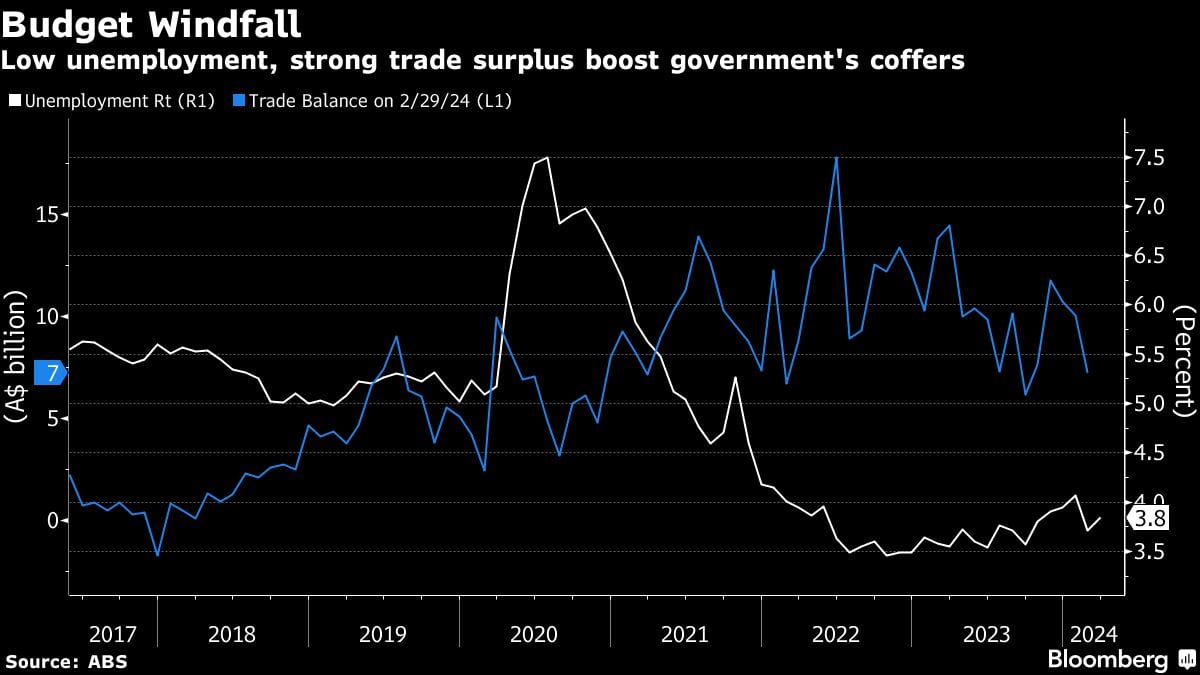(Bloomberg) -- Australia is on track to deliver a second consecutive budget surplus even as mounting headwinds in key trading partner China and geopolitical tensions weigh on its economy, Treasurer Jim Chalmers said in Washington.
Chalmers will hand down his latest fiscal blueprint in just under four weeks’ time, though as in previous years major announcements of economic policies and projections are expected to be trickled out in the lead up to the release.
“The degree of difficulty on that second surplus has come up a little bit,” Chalmers said in an interview with Bloomberg Television in Washington, where he’s attending meetings of the International Monetary Fund and World Bank. “That’s certainly our goal - we’re not quite there yet,” he said, adding that the economy is slowing and the labor market is softening.
Chalmers became the first Australian treasurer in more than a decade to announce a budget surplus in the fiscal year ending June 2023, underpinned by elevated commodity prices and a tight labor market. But with the local economy slowing under the weight of restrictive monetary policy and the geopolitical backdrop darkening, this may prove to be the last one for a while.
The center-left Labor government has run a tight fiscal policy since winning office in May 2022 to try to help the central bank bring down inflation, sparking a cost-of-living squeeze for Australians. It’s now hoping tax cuts beginning in July and potential interest-rate cuts will ease pressure on heavily-indebted households and spur voters to re-elect the government at a poll due by mid-2025.
“We will ease people’s cost of living pressures where we can with a tax cut for every taxpayer in our budget, but a big emphasis on investing in the future as well,” Chalmers said. However, he cautioned that pressures on the budget are “intensifying rather than easing” in the medium term, and “the revenue upgrades in this budget will be much, much smaller than what we’ve seen.”
Chinese Growth
China is Australia’s largest trading partner and its demand for iron ore and other minerals has helped prop up prices and brought a fiscal windfall for the government’s coffers. Still, China’s wobbly property sector is a constant cause for concern when it comes to the strength of future demand for Australia’s resource exports.
“Chinese growth has still been off a bit, has still been softer than a lot of us would like to see. And in our own budget we will forecast relatively sluggish growth by Chinese standards,” Chalmers said, pointing out that iron ore prices have fallen recently. That’s the case “even though that number on Tuesday came in a little stronger than what people were anticipating,” he said.
Read More: Chinese Economy’s Strong Start to 2024 Is Already Fading
On the upside, Beijing has removed most of its curbs on Australian exports that were imposed on the previous center-right government as ties went into freefall. Since Labor’s election in May 2022, relations have steadily improved, though they’re unlikely to return to previous highs given Beijing is now taking a more assertive military stance in the region.
RBA Reform
Chalmers declined to comment on monetary policy, but said he hoped that new central bank legislation would pass parliament soon. Australia’s government and opposition are at loggerheads over the makeup of the Reserve Bank’s new monetary policy committee, a showdown that threatens to derail legislation needed to overhaul the institution.
The Liberal-National coalition is demanding the government’s RBA reform bill require all current board members to transition to a new monetary policy committee. Under the current version, Chalmers has the discretion to give them the option of joining the committee or a new governance board that will oversee the central bank.
Future Made in Australia
Prime Minister Anthony Albanese last week announced plans for an Inflation Reduction Act-style program to stimulate Australia’s green manufacturing industries and drive the economy beyond its traditional minerals extraction base while bolstering economic security.
By year’s end, the government will legislate the “Future Made in Australia Act,” which is intended as a catchall for “new and existing initiatives” to boost investment and create jobs in the fields of green manufacturing and high-tech.
Australia’s goal is to be a “renewable energy superpower,” Chalmers said, adding that Australia is confident that it can attract private investment into the sector, but he didn’t think this will lead to higher inflation. The government is considering “substantial” investments but they won’t all be in the first year, Chalmers said.
--With assistance from Swati Pandey.
(Updates with additional comments.)
©2024 Bloomberg L.P.
